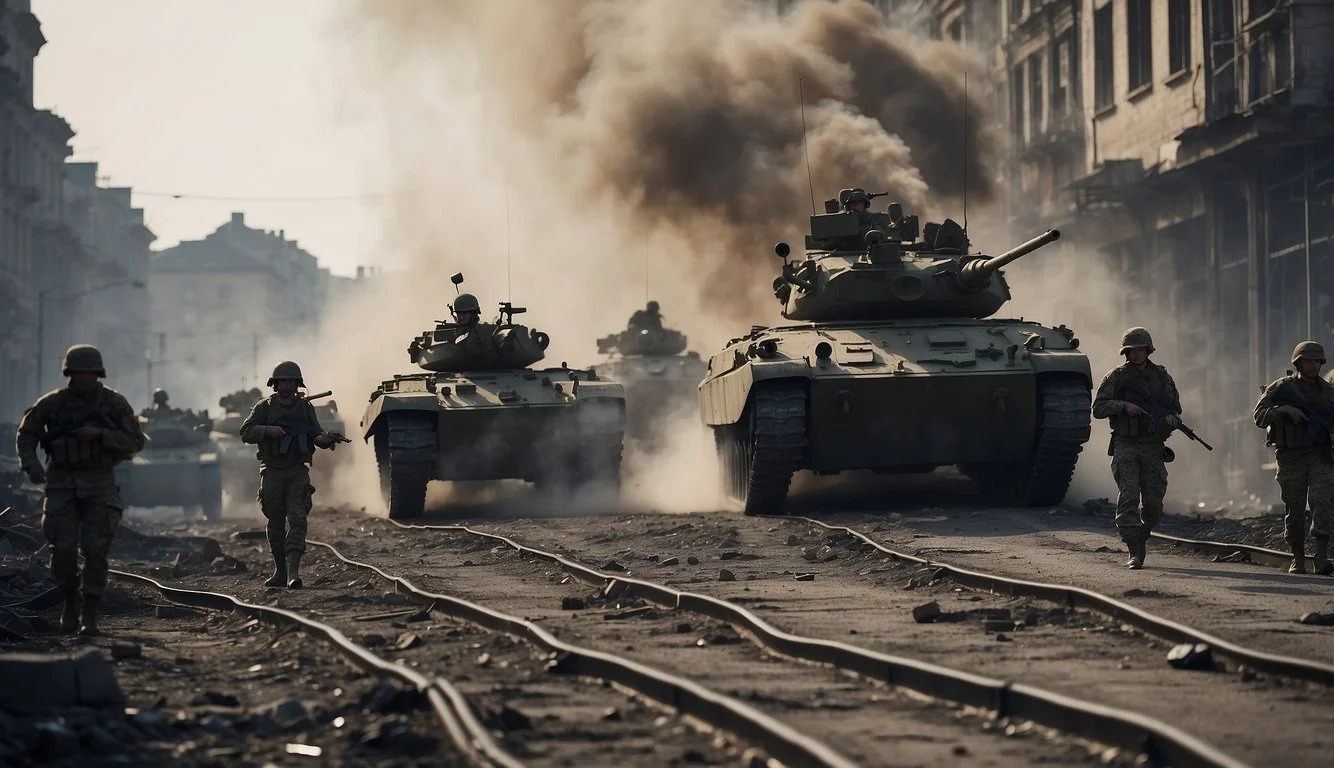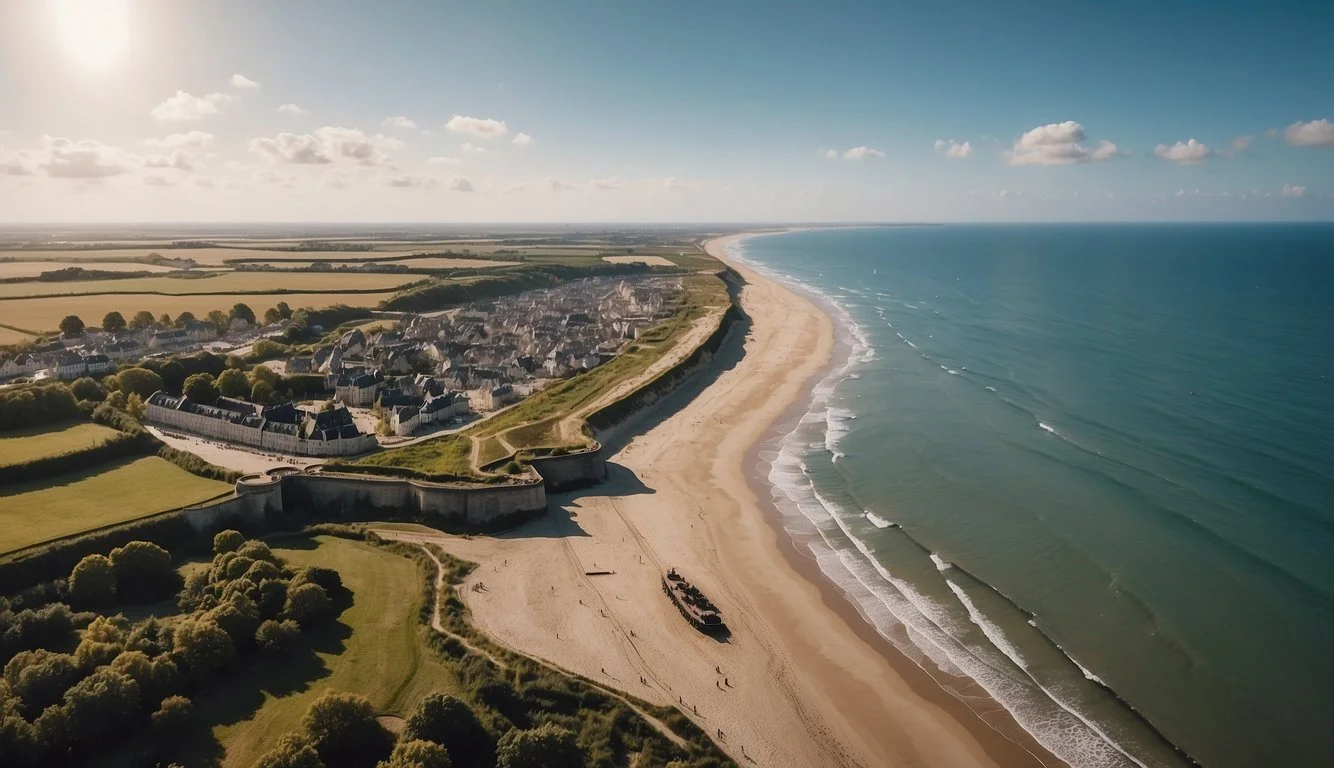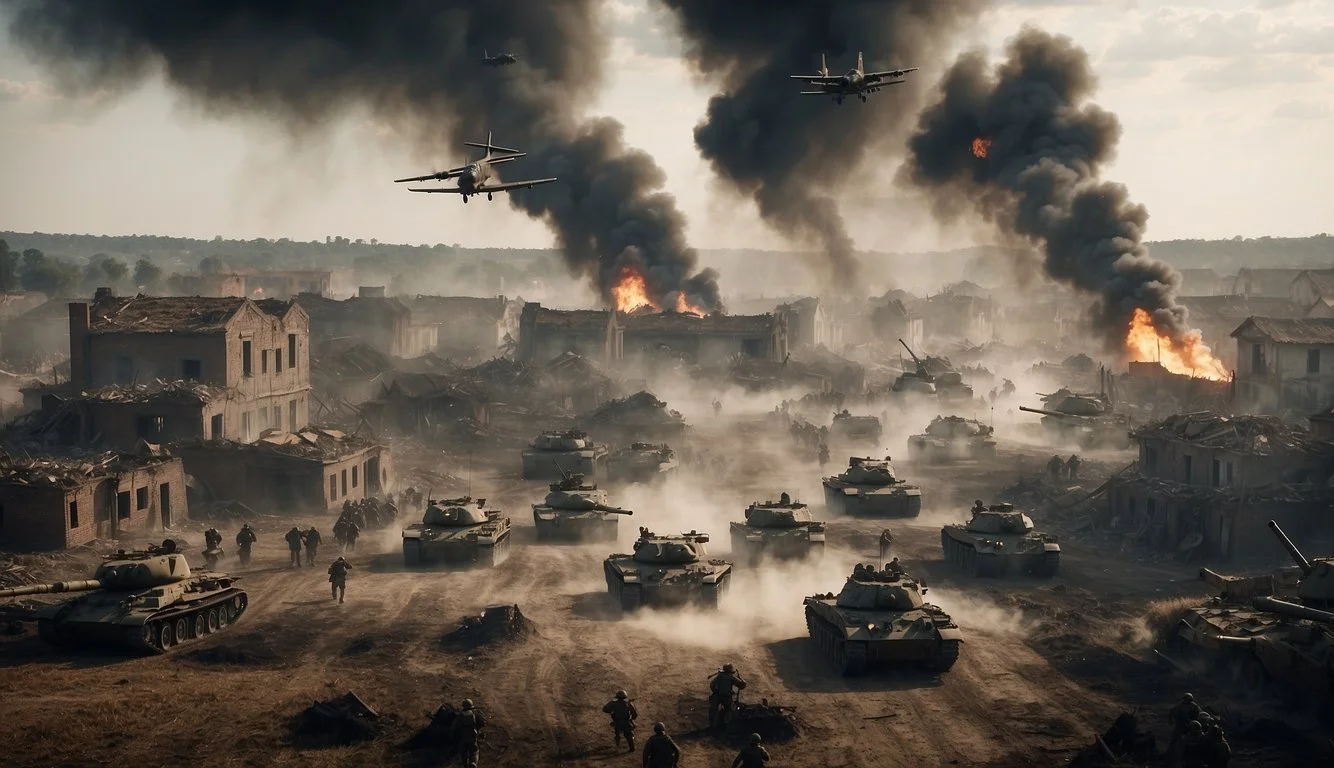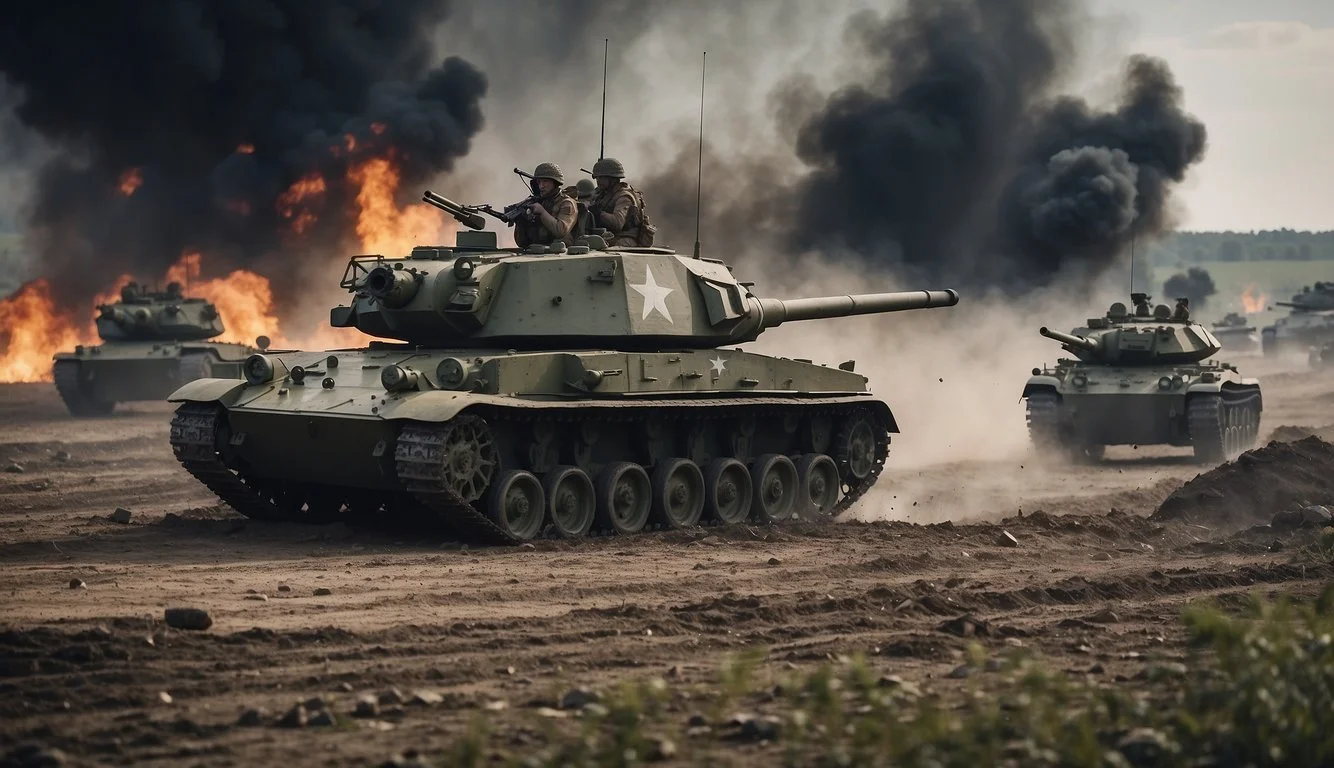Documentary Review: World War II: From the Frontlines (2023)
A Comprehensive Analysis of Wartime Narratives
"World War II: From the Frontlines" (2023) offers an unparalleled view into the most significant conflict of the 20th century. Directed by Rob Coldstream and narrated by John Boyega, this six-part docuseries utilizes vividly enhanced archival footage to bring the realities of World War II to life with remarkable clarity. By featuring voices from all sides of the conflict, the series provides a comprehensive and immersive experience that is both educational and emotionally engaging.
The docuseries stands out for its innovative use of colorized archival footage, making historical events more relatable and visually captivating for modern audiences. Scenes of intense battles, personal stories of soldiers, and the poignant experiences of civilians are meticulously depicted, ensuring that viewers gain a deep understanding of the war's complexities and human cost.
With contributions from notable figures such as Hans-Erdmann Schönbeck and George Mussbach, the series ensures a wide range of perspectives are represented. This approach not only humanizes the narrative but also underscores the global impact of World War II. The meticulous attention to detail and narrative structure positions "World War II: From the Frontlines" as a must-watch for anyone interested in understanding the profound impact of this pivotal period in history.
Contextual Background of World War II
World War II, a global conflict that lasted from 1939 to 1945, had profound political, social, and economic repercussions. Understanding the context requires examining the events leading up to the war, the key nations involved, and the global climate of the time.
Prelude to the War
The roots of World War II trace back to the unresolved tensions of World War I. The Treaty of Versailles imposed harsh reparations on Germany, leading to economic hardship and deep resentment. The rise of totalitarian regimes across Europe, such as Hitler's Nazi Germany and Mussolini's Fascist Italy, further destabilized the continent.
Key Events:
1931: Japan invaded Manchuria, marking early aggression in East Asia.
1938: Germany's annexation of Austria (Anschluss) and the Sudetenland.
1939: The Molotov-Ribbentrop Pact, a non-aggression treaty between Germany and the Soviet Union.
Major Powers Involved
Several major powers were involved in World War II, each bringing unique strategic interests and resources to the conflict. The two primary alliances were the Allies and the Axis.
Allies:
United States: Entered the war after Japan's attack on Pearl Harbor in 1941.
Soviet Union: Initially allied with Nazi Germany but joined the Allies after Operation Barbarossa in 1941.
United Kingdom: Led by Winston Churchill, a significant player throughout the European theater.
Axis Powers:
Germany: Initiated the war by invading Poland in 1939.
Japan: Sought to expand its influence in Asia and the Pacific.
Italy: Allied with Germany but switched sides in 1943 after Mussolini's downfall.
Political and Social Climate
The political and social environment leading up to and during World War II was characterized by ideological conflicts and widespread upheaval. Totalitarian regimes promoted aggressive nationalism and militarism, rejecting democratic principles and human rights.
Political Climate:
Fascism: Prominent in Italy under Mussolini and in Germany under Hitler.
Communism: Dominant in the Soviet Union under Stalin.
Imperialism: Japan pursued expansionist policies in Asia.
Social Climate:
Economic Struggles: The Great Depression of the 1930s had a global impact, leading to high unemployment and poverty.
Propaganda: Used extensively by all governments to rally public support and demonize the enemy.
Persecution: Significant human rights abuses, including the Holocaust, and Japanese internment camps in the US.
Overview of 'World War II: From the Frontlines'
"World War II: From the Frontlines" is a powerful docuseries using vivid archival footage to illustrate the events of World War II, featuring narratives from diverse perspectives and voices from all sides of the conflict.
Filmmakers and Production
This docuseries stars John Boyega alongside notable contributors Hans-Erdmann Schönbeck, George Mussbach, and Gerhard Dengler. The series utilizes colorized archival footage, enhancing the visual experience and bringing historical moments to life with modern techniques.
Released in 2023, the series is produced in collaboration with Netflix, ensuring a high production quality. The choice to use real wartime footage aims to deliver an authentic and immersive viewing experience.
Documentary Synopsis
"World War II: From the Frontlines" delves into the significant events from the war, vividly presenting them through colorized archival footage. The series captures the harsh realities and intense emotions of the conflict, making history tangible.
This approach aims to provide a fresh perspective on the war, making it accessible and engaging for contemporary audiences. The use of voices from all sides of the conflict adds depth, showing the multifaceted nature of World War II and allowing viewers to hear a broad spectrum of experiences and stories.
Critical Analysis
This analysis delves into the narrative structure, cinematography, use of archival footage, and the soundtrack and scoring of the documentary series "World War II: From the Frontlines" (2023).
Narrative Structure
The series employs a chronological approach, guiding viewers through significant events of World War II. Narration is led by John Boyega, who lends a steady and engaging voice to the storytelling.
Each episode focuses on different phases or pivotal moments. This structuring makes the complexity of the war accessible, drawing the audience into both well-known and lesser-known incidents.
There is a balance of personal stories and broader military strategies. This dual focus enriches the viewer’s interest. The series avoids oversimplification, presenting a nuanced portrayal of the conflict.
Cinematography
The cinematography is a standout element, enhancing the gravitas of the subject matter. The series utilizes high-quality colorized footage, transforming black-and-white historical recordings into vibrant, striking visuals.
The framing of interviews and contemporary shots is methodical. Attention to detail in shot composition adds a layer of professionalism and depth.
Archival footage transitions seamlessly with modern re-enactments and interviews. The cinematographic approach ensures that viewers remain visually engaged throughout the episodes, adding an almost cinematic feel to the historical narrative.
Use of Archival Footage
Archival footage is a pivotal aspect of this documentary. The series excels in incorporating historically significant footage, with enhancements that preserve authenticity while improving visual clarity.
Footages from various global archives are seamlessly integrated. The footage shows perspectives from multiple sides of the conflict, supporting the series' aim of a comprehensive portrayal.
Colorization of the footage makes historical events feel immediate and real. This technique, coupled with expert editing, ensures visual continuity and an immersive viewing experience.
Soundtrack and Scoring
The soundtrack complements the documentary's atmosphere, balancing between dramatic and subtle tones. The score underscores events without overpowering the narrative, accentuating moments of tension and resolution.
Music is used strategically to evoke emotional responses. Battle scenes are paired with intense, heart-pounding compositions, while reflective moments feature softer, poignant scores.
Sound engineering ensures clarity, allowing narrations and interviews to stand out against the background music. This careful design enhances the storytelling, making the documentary both informative and emotionally resonant.
Key Figures and Testimonies
The documentary "World War II: From the Frontlines (2023)" shines a light on the pivotal figures and the raw, unfiltered experiences of those who lived through the conflict. It vividly portrays military leaders, soldiers on the battlefield, and civilians affected by the war.
Military Leaders
Several renowned military leaders are featured, adding depth to the narrative with their decisive actions and strategies. General Dwight D. Eisenhower, the Supreme Allied Commander, plays a crucial role, highlighting his leadership in orchestrating the D-Day invasion. Field Marshal Bernard Montgomery, known for his strategic brilliance in battles like El Alamein, provides insights into the European theater.
Meanwhile, the depiction of General George S. Patton captures his aggressive tactics and charisma, essential to the Allied push in Europe. This section covers their contributions thoroughly, with enhanced archival footage and personal diaries, illustrating their impact on the war's outcome.
Soldiers' Experience
The documentary places a strong emphasis on the experiences of soldiers from various nations. Through the voices of veterans such as Hans-Erdmann Schönbeck and George Mussbach, viewers gain a personal perspective of the brutal realities faced on the frontlines.
Enhanced colorized footage vividly captures the grim and harrowing moments from the soldiers' point of view. Stories of courage, fear, and camaraderie from diverse backgrounds, including American, British, and German soldiers, are intertwined, showcasing the universal yet individual struggles encountered during the conflict.
Civilians' Perspective
The civilian perspective offers a poignant contrast to the military focus. The series presents accounts from civilians who lived through bombings, displacement, and occupation. For instance, personal testimonies from residents of Poland detail the horrifying ordeal of being caught in the crossfire between warring powers.
Dramatic retellings from French and Dutch civilians illustrate the day-to-day challenges and resilience in occupied territories. The documentary does not shy away from the darker aspects, such as the removal of children from their families, providing a comprehensive view of the war's impact on society.
Significant Battles and Campaigns
The docuseries "World War II: From the Frontlines" provides an in-depth look at key battles and campaigns that shaped the outcome of the war. This section explores major events in both the European and Pacific theaters, along with turning points that shifted the war's momentum.
European Theater
The European Theater saw some of the most intense and pivotal battles of World War II. The Battle of Stalingrad, fought from August 1942 to February 1943, was a significant turning point. The brutal urban warfare led to massive casualties but ultimately halted the German advance into the Soviet Union.
In Western Europe, Operation Overlord, also known as D-Day, was crucial. On June 6, 1944, Allied forces landed on the beaches of Normandy, France. This large-scale invasion marked the beginning of the end for Nazi Germany as it led to the liberation of Western Europe.
The Battle of the Bulge, occurring in December 1944, was Germany's last major offensive on the Western Front. Despite initial successes, the Allies managed to repel the German forces, further weakening their position in Europe.
Pacific Theater
In the Pacific Theater, the Battle of Midway in June 1942 was a crucial naval engagement. The US Navy's decisive victory against the Japanese fleet shifted the balance of power in the Pacific. This battle marked the beginning of the US's strategic offensive in the region.
The Guadalcanal Campaign, from August 1942 to February 1943, was the first major Allied offensive against Japanese forces. The fierce fighting on land, sea, and air in the Solomon Islands highlighted the strategic importance of controlling the Pacific.
Another significant battle was the Battle of Iwo Jima, fought from February to March 1945. This iconic battle saw US forces capturing the island, providing a base for air operations and paving the way for the invasion of Okinawa.
Turning Points of the War
Turning points in World War II were critical in shifting the momentum. The Battle of Stalingrad and the Battle of Midway stand out as key moments.
Stalingrad's outcome saw the Soviet Union changing from defensive to offensive operations, pushing westward toward Berlin. In contrast, Midway's impact enabled the US to transition from a defensive stance to an offensive one, leading to further victories across the Pacific.
The successful landing during D-Day was another turning point. It hastened the collapse of Nazi Germany by opening a new front and forcing German divisions to fight on multiple fronts.
Historical Accuracy
The documentary "World War II: From the Frontlines" delivers a visually striking portrayal of World War II through colorized archival footage and real testimonies from those who experienced the conflict firsthand.
Fact-Checking the Content
The series makes significant efforts to verify the accuracy of its content. Historical documents, military records, and first-person accounts are thoroughly checked against each other. These sources confirm the events, dates, and figures presented. Archival footage has been cross-referenced with established historical records to avoid any discrepancies. This meticulous approach ensures that viewers receive a faithful representation of World War II events.
Experts' Contributions
Historians and military experts contribute significantly. John Boyega’s narration is complemented by insights from scholars specializing in World War II. Their expertise helps to contextualize the footage and interviews presented. Input from experts like Hans-Erdmann Schönbeck and George Mussbach adds depth, offering commentary that aligns with known historical facts, thus verifying the series' portrayal of the conflict.
Comparative Analysis to Other Works
"World War II: From the Frontlines" can be compared to other documentaries in its genre. Unlike some productions that focus on specific battles or figures, this series provides a broader view through enhanced archival footage and multiple perspectives. It effectively uses colorization to bring a fresh, immersive experience. This contrasts with more traditional, black-and-white documentaries, making the historical events more relatable to contemporary audiences.
Cultural and Educational Impact
"World War II: From the Frontlines (2023)" offers a significant contribution to both cultural understanding and educational enrichment by providing vividly enhanced archival footage and personal stories. This section explores its influence on public perception and its educational value for viewers.
Influence on Public Perception
"World War II: From the Frontlines" reshapes how audiences view historical events by using colorized archival footage and voices from all sides of the conflict. It bridges generational gaps, making historical events more tangible and relatable to modern audiences.
Viewers gain a more immersive experience, seeing the conflict in full color, which contrasts starkly with traditional black-and-white footage. This visual approach fosters greater empathy and a deeper connection to the personal stories depicted.
By presenting multifaceted perspectives, the series challenges and broadens traditional narratives. It highlights the human aspects of war, including the experiences of soldiers, civilians, and political leaders, thus providing a nuanced understanding of the conflict's global impact.
Educational Value for Viewers
The educational value of "World War II: From the Frontlines" lies in its meticulous presentation of historical facts combined with personal testimonies. It serves as a rich resource for learning about the key events and figures of World War II, making it ideal for educators and history enthusiasts.
The series is particularly beneficial for secondary education, offering insights that go beyond standard textbooks. It includes lesser-known events and diverse viewpoints, prompting critical thinking and discussion among viewers.
Through powerful storytelling and detailed visual representations, the docuseries helps viewers comprehend the complexities of the war. It serves as a supplementary educational tool, enhancing the learning experience by providing context, emotional depth, and a comprehensive view of the conflict.
Ethical Considerations
The portrayal of historical events in documentaries like World War II: From the Frontlines (2023) necessitates careful ethical considerations. These include the representation of violence and the handling of sensitive subjects to ensure respectful and accurate storytelling.
Representation of Violence
In World War II: From the Frontlines, violence is depicted through colorized archival footage, aiming to bring historical events to life. This approach can be impactful but also raises ethical questions.
Sensitive treatment of violent imagery is crucial to avoid sensationalism. The documentary uses intense visual content, such as scenes of children in wartime, which may be disturbing to some viewers. Ensuring that this content is presented with proper context and warnings helps mitigate potential psychological impacts.
Documentaries must balance the need to depict the harsh realities of war with the responsibility to not desensitize or exploit. The ethical challenge lies in presenting violence in a way that honors the experiences of those who lived through it without causing undue distress to the audience.
Handling Sensitive Subjects
Historical documentaries must handle sensitive subjects with a high degree of care. World War II: From the Frontlines addresses themes like displacement, trauma, and wartime atrocities. Accurately representing these experiences is vital for educational and memorial purposes.
The series includes perspectives from various sides of the conflict, which can enhance understanding and empathy but requires careful consideration to avoid bias or misrepresentation. Using firsthand accounts, the documentary ensures that the narratives of those affected are represented respectfully.
Ethical storytelling involves prioritizing the dignity and humanity of subjects. Any portrayal of sensitive topics should be executed with empathy, ensuring that the documentary serves as a respectful tribute rather than a mere recounting of events.
Conclusion and Recommendations
World War II: From the Frontlines (2023) offers a unique and gripping look at one of the most important periods in history. The series stands out due to its vivid colorized archival footage and powerful narration.
Final Thoughts on the Documentary
World War II: From the Frontlines presents a well-rounded and intense portrayal of the war. Directed by Rob Coldstream and narrated by John Boyega, the series manages to breathe new life into historical events through enhanced footage and interviews with experts.
The inclusion of rarely seen clips and firsthand accounts enhances the educational value of the series. The careful attention to detail in the visuals adds authenticity, making it a useful resource for both history enthusiasts and casual viewers. This series is particularly notable for its ability to convey the gravity and complexity of World War II without resorting to sensationalism.
Recommendations for Further Viewing
For those intrigued by World War II: From the Frontlines, there are several other documentaries worth exploring.
The World at War (1973) remains a seminal work that provides in-depth analysis of the war from multiple perspectives. Ken Burns' The War (2007) offers a poignant look at the American experience during the conflict, utilizing personal stories and comprehensive research.
Additionally, the BBC's World War II in Colour offers a similar approach in terms of colorized footage but covers different aspects and events. These documentaries complement the themes found in World War II: From the Frontlines and provide a broader understanding of the war’s impact on global history.






